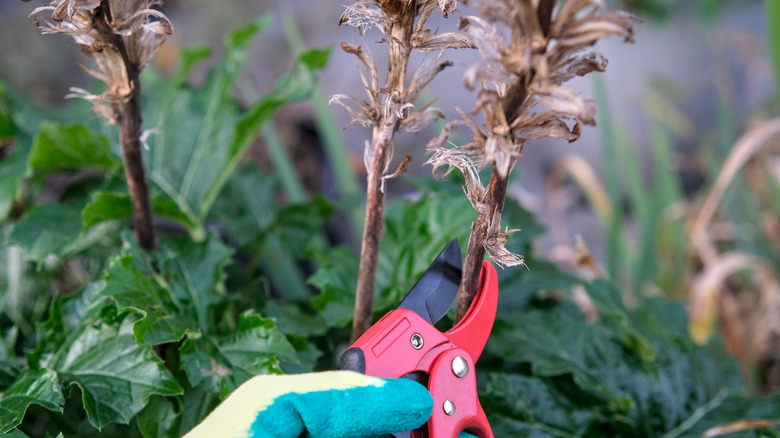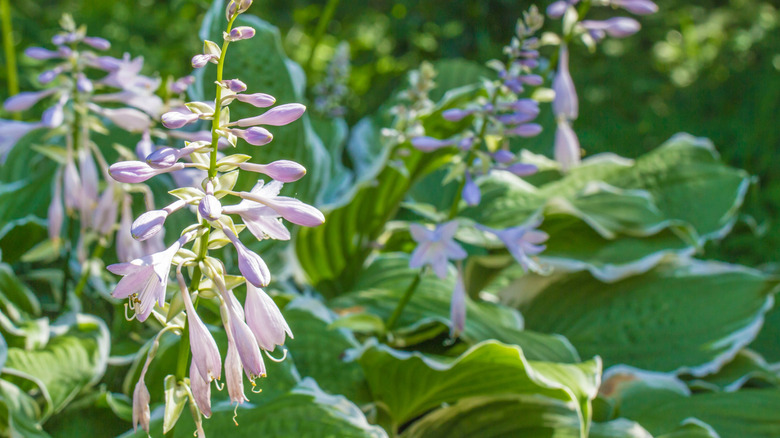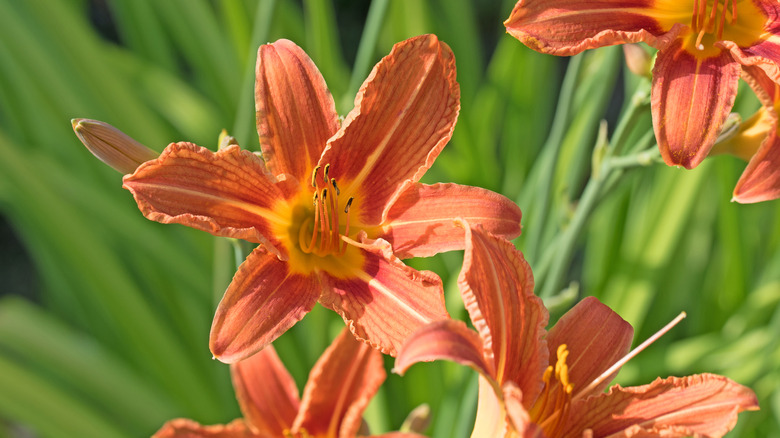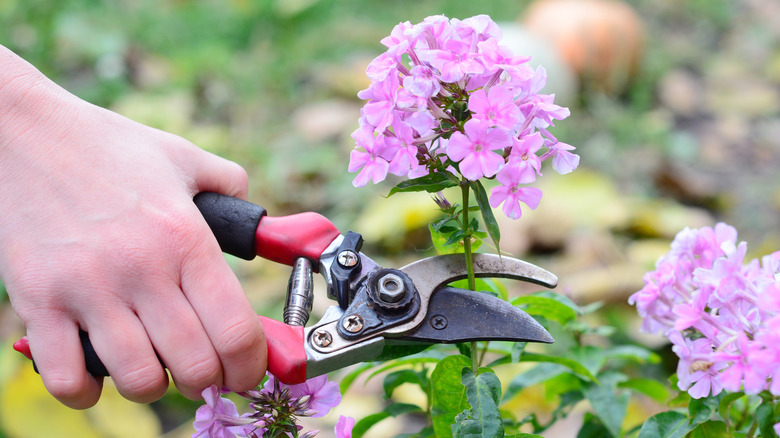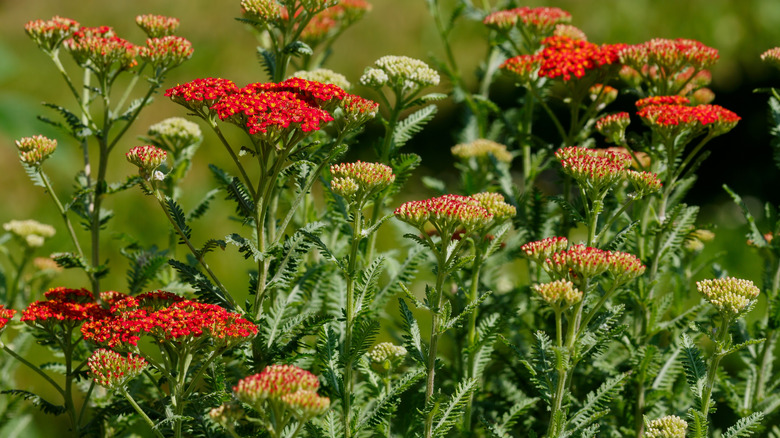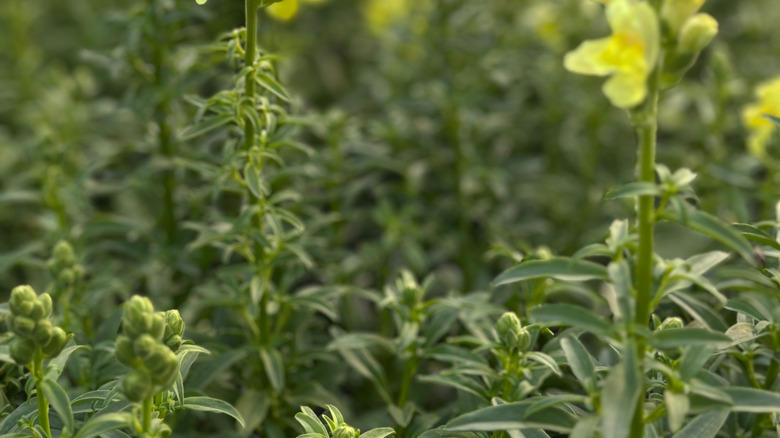10 Plants That Need To Be Cut Back After The First Frost
It's common knowledge that you should be pruning some plants in the fall, but this doesn't necessarily mean they all need attention from your shears right away. While some plants are best trimmed in September, the period after the first frost is the time to cut back certain withered annuals and perennials. This includes daylilies, snapdragons, and irises, depending on your local weather conditions. Cutting them back can help keep them free from infection and pests while improving their next blooming season. It's generally best to cut them a couple of inches above the ground and remove any parts that are dead or affected by disease or insects.
Since you'll want perennials to come back in the spring, there are some points to keep in mind when you cut them back. Using bypass pruners with sharpened blades means you're less likely to bruise the plant. If you're cutting into a large clump of plants, try using hedge clippers for a quicker job. Also, once you've cut back a perennial, it's useful to mark the plant's location so it doesn't get disrupted when it's time to do spring gardening tasks. Leaving more of the stalk intact can also accomplish this.
There are also some plants that shouldn't be cut back at all. Birds munch on seeds from perennials like black-eyed Susans (Rudbeckia hirta) over the winter, so keeping them fully intact nourishes local wildlife. And while you can shape the evergreen shrubs that will brighten up your yard in the winter, there's generally no need to prune them all the way back to the ground.
Hosta
There are many reasons to grow hostas, from their trumpet-like flowers to their attractive leaves and ability to thrive in the shade. They grow best in USDA Hardiness Zones 3 through 9, where you should wait until after the first frost to cut them back. It's worth the wait — hostas need to go dormant and be exposed to cold temperatures for a while so they can stay hardy. The first frost makes the leaves flat, which is a sign to cut them back so slugs and snails, common pests for hostas, have fewer places to hide.
Garden peony
Herbaceous peonies (Paeonia lactiflora) are the shrubby, perennial type that is most popular with gardeners, grown for their big, showy blooms. Hardy in zones 3 to 8, their foliage dies in winter, when their buds are forming underground. It's best to wait until after a hard frost to cut these plants to 1 or 2 inches above the ground. This gives their root systems time to store up energy from the foliage for a strong spring blooming season. Pruning this flower in October after the first frost also helps prevent fungal infections from taking hold.
Daylily
The first frost kills the foliage of daylilies (Hemerocallis), which bring large, bell-shaped flowers to zones 3 through 9. It's easiest to give them a hard pruning at this time, because you won't have to be careful not to affect growth like you would if you waited until spring. Cutting daylilies back also allows air to circulate around the plant, so it will re-emerge healthy. However, if your daylily's foliage stays green, you have an evergreen type that does not need to be cut back — just clean it up if it gets damaged.
Tall phlox
The risk of plant infection is the main reason to cut tall phlox (Phlox paniculata) back after the first freeze. Pruning phlox in the fall after a frost helps control powdery mildew, a disease that leaves white spots on the foliage and can destroy the plant. But pay attention before you cut — woody and creeping species like moss phlox (Phlox subulata) should be left alone until the spring. For tall garden phlox, which grows in zones 4 through 8, remove the dead stems and leaves and cut the remaining stems to 2 inches above the soil.
Calla lily
The striking calla lily (Zantedeschia), with a spike of tiny flowers surrounded by a white or colorful curved bract, can't always survive the cold season outdoors. Cut them back after the first frost to 1 or 2 inches above the ground to support their dormancy, especially if you're on the cooler edge of their growing range in zones 7 through 10. You can let their rhizomes stay in the ground over the winter or winterize your calla lilies indoors. When bringing them inside, dig up their underground stems for drying and storing in a medium like peat moss.
Columbine
A post-frost pruning is an option for the columbine (Aquilegia) you may be growing in your garden. By the time the first frost has passed, this perennial, which thrives in zones 3 through 8, most likely has been dormant for a while, and you can cut damaged foliage until there are 2 to 3 inches of the plant left above ground. This is a good opportunity to discard leaves that may be infested by leaf miners, a common pest of columbine, making sure the young insects don't overwinter into the next season.
Yarrow
It's smart to cut back yarrow (Achillea millefolium) after the first frost, but it doesn't have to be drastic. You can leave some of these 1 to 3-foot-tall perennials intact if it's aesthetically pleasing. Also, leaving around 6 inches of height to the stalk can help distinguish the plant from the weeds that get pulled in the next season. If you cut further down, definitely avoid removing the leaves at the plant's base; they protect the yarrow in the cold and will be the start of its regrowth after the winter.
Snapdragon
Your treatment of snapdragon (Antirrhinum majus) after the first frost will vary depending on where you live; these uniquely-shaped plants can be grown as either annuals or perennials. In zones 7 through 10, where they're hardy enough to be treated as perennials, cut their stems to the soil level after the first frost. This helps prevent fungus, which snapdragons are susceptible to, from forming amid winter moisture. In other regions, you'll want to pull out the whole plant after its long flowering season is over, and bring snapdragon inside or add the healthy plant parts to your compost.
Bee balm
Be sparing in your cut-back of bee balm (Monarda didyma), since it's a plant pollinators love. Give this flowering perennial a trim after the first frost to encourage healthy spring growth while giving seeds time to spread in the fall. The plant can reach up to 4 feet tall across zones 4 through 9. When you cut, leave between 12 and 24 inches of stalk intact to provide native bees with a winter nesting place.
Iris
Your garden's beautiful irises, which produce showy blooms in zones 5 through 9, are most likely faded after the first frost, so it's time to cut them back when the leaves start looking brown. You can prevent rot by cutting them to 1 or 2 inches above the ground. This also helps prevent a pest called the iris borer from taking hold. This care applies to both beardless and bearded irises. The third iris variety type, the bulbous iris, is just beginning its life cycle as a bulb planted in the fall.
